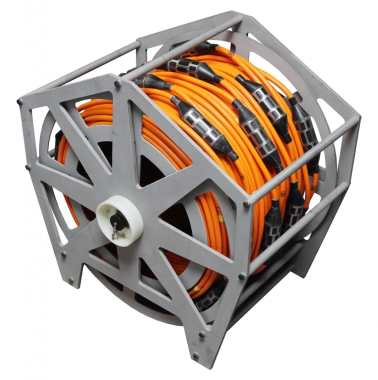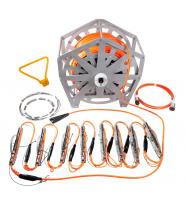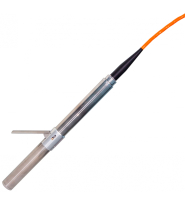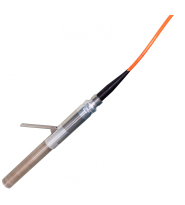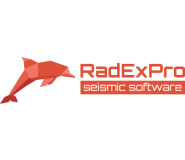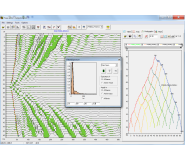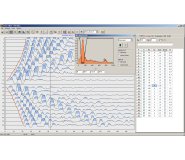Borehole hydrophone array WellStreamer
WellStreamer is a borehole hydrophone array, specially developed for seismic acquisitions in water-filled wells. We designed an exceptionally easy to use and robust receiver tool with sensitive acceleration-free piezoceramic sensors and signal preamplifiers in each module for registering compressional (P) waves during VSP, cross hole surveys, parallel seismic testing, and other high-resolution borehole seismic techniques. WellStreamer is also used for geotechnical monitoring of the structure of berths, dams, and other hydraulic structures - in this case, it can be located below the water surface on one side of the construction. Measuring the length of piles by parallel seismic testing, geotechnical control of the soil stabilization process, control of the continuity and thickness of the ice wall during the mine shaft construction are also hydrophone array applications.
WellStreamer can be supplied in various configurations, starting from 4 channels and up to 48 units with a typical separation of 1 m or 2 m. It can be equipped with a connector for reference land geophone to control source-seismograph synchronization during VSP survey and to improve the accuracy of interval velocities calculation. Signal registration is provided by almost any seismograph.
Mounted on a reel with a slip ring, which can be ordered with the streamer, it provides easy to operate data acquisition solution without spending time on unplugging equipment during cable operations. The convenience and safety of work in deep wells are ensured by specialized winches BGW and BGW light.
WellStreamer and 3C borehole array (GStreamer / GStreamer-P / GStreamer-E) with sources of pressure and shear waves Pulse, SHock, or GeoSV is an advanced equipment set for Crosshole Seismic Testing (ASTM D4428 / D4428M) or multiwave tomography with P and S waves registration. These technologies are designed to determine the Poisson's ratio and dynamic moduli of the studied geological layers in natural occurrence. Please see details here.
Areas of application of WellStreamer:- Borehole seismic surveys on land and in water areas using cross-hole seismic testing and tomography (CST), vertical seismic profiling (VSP), high-resolution VSP, low-frequency acoustic logging, seismic side scanning, etc.
- Engineering surveys for the construction of highly sensitive facilities
- Search for karsts, fractured and deconsolidated zones, and mining geophysics
- Mineral exploration
- Geotechnical monitoring of the soil foundation and determination of its load-bearing capacity, including in accordance with ASTM D4428 / D4428M standard
- Crosshole logging of concrete foundations, piles, retaining walls, diaphragm foundations, dams, etc.
- Soil stabilization control
- Control of the continuity and thickness of the ice wall during the mine shaft construction
- Cracks location in concrete hydroelectric dams
- Parallel seismic testing of pile or foundations
- Hydrophone array WellStreamer
- Battery with charger
- Holder for fixing the array on the wellhead
- Reel with slip ring
- BGW or BGW light winch
- Energy source Jack with remote control JackPad
- Borehole sources of pressure (P) waves (Pulse) or shear (S) waves of horizontal (SHock) and vertical (GeoSV) polarization
- Single and multi-level 3C borehole probes with spring (GStreamer), pneumatic (GStreamer-P), and electromechanical (GStreamer-E) anchoring systems
- High-frequency seismographs Sigma 4+ or DAQlink 4
- Borehole inclinometer INCLIS
|
Number of channels |
4, 6, 12, 24, or 48 |
|
Operating frequency |
10 - 10 000 Hz |
|
Electric capacity of the piezoelectric element |
4 000 pF |
|
Sensitivity of the piezoelectric element |
180 µV / Pa |
|
Maximum working pressure |
60 atm |
|
Destructive pressure |
> 100 atm |
|
Sensitivity to accelerations |
acceleration-free |
|
Change in sensitivity depending on the depth |
no |
|
Type of the preamplifier |
low-noise asymmetrical |
|
Gain of the preamplifier |
6 dB |
|
Power supply voltage |
bipolar from ±11 to ±16 V |
|
Current per channel |
10 mA |
|
Output impedance of the preamplifier |
395 Ω |
|
Maximum value of the output signal |
±3.8 V |
|
Mean square voltage of the intrinsic electrical noise (output) in the working bandwidth does not exceed |
10 µV |
|
Operating temperature range |
-10 ÷ +70 °С |
|
Storage temperature range |
-40 ÷ +70 °С |
|
Hydrophone module diameter |
42 mm |
|
Length of the hydrophone module |
200 mm |
|
Weight of the hydrophone module |
300 g |
|
Inter-hydrophone distance on the array |
on request, but ≥ 0.25 m |
|
Cable shielding material |
polyurethane |
|
Longitudinal hermitization of the cable |
yes |
|
Shielding of the cable and hydrophone module |
yes |
|
Cable reinforcement |
kevlar |
|
Working load |
200 kg |
|
Breaking load |
> 400 kg |
|
Cable diameter |
13 mm |
|
Minimum bend radius of the cable |
120 mm |
|
Minimum bend radius of the active section |
220 mm |
|
Cable weight |
168 g/m |
|
Weight of the 130-meter hydrophone array with a reel |
38 kg |
|
Dimensions on a reel |
760×775×400 mm |
|
Maximum length of the hydrophone array |
700 m |
|
End connector |
by agreement |



